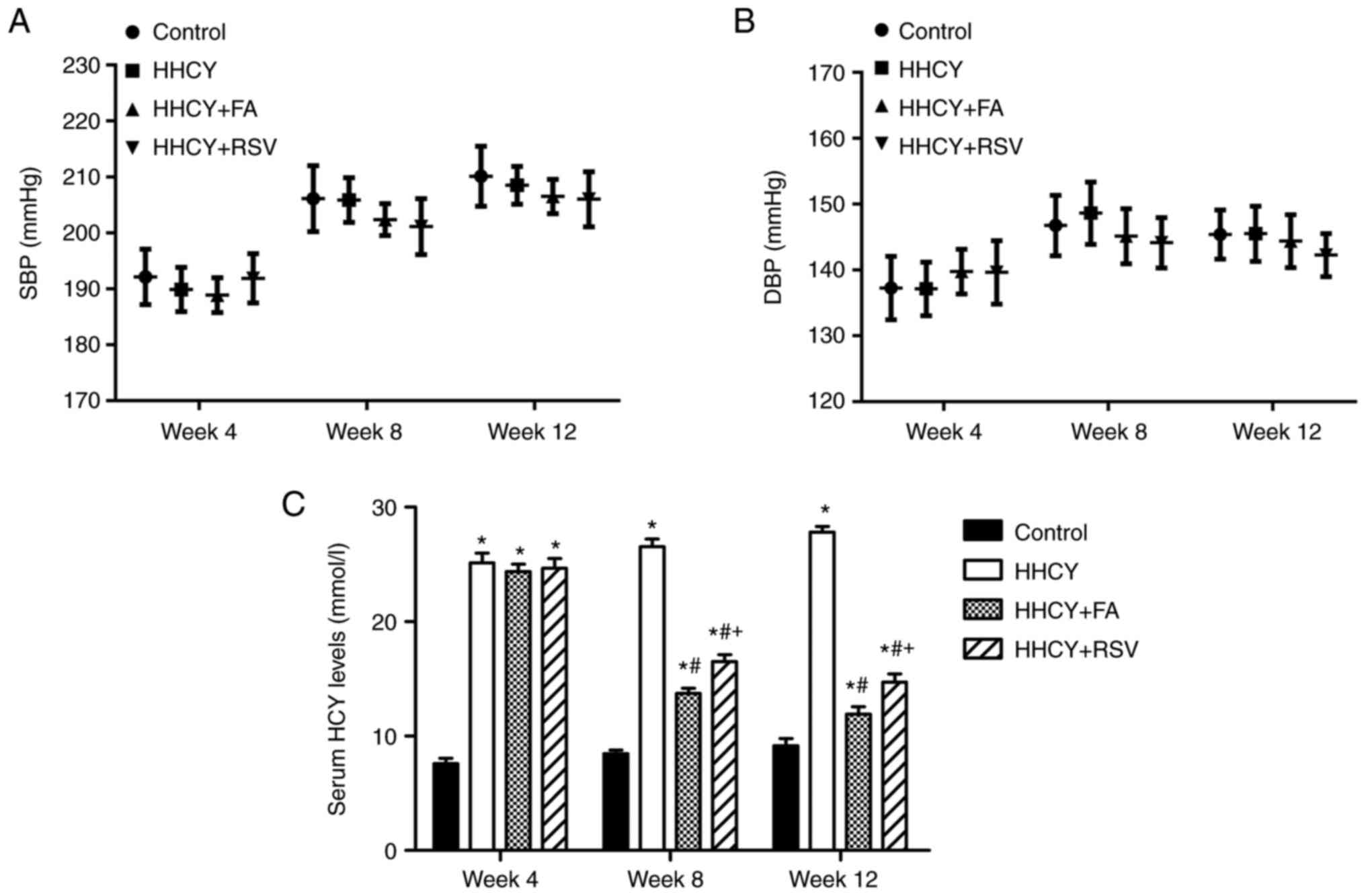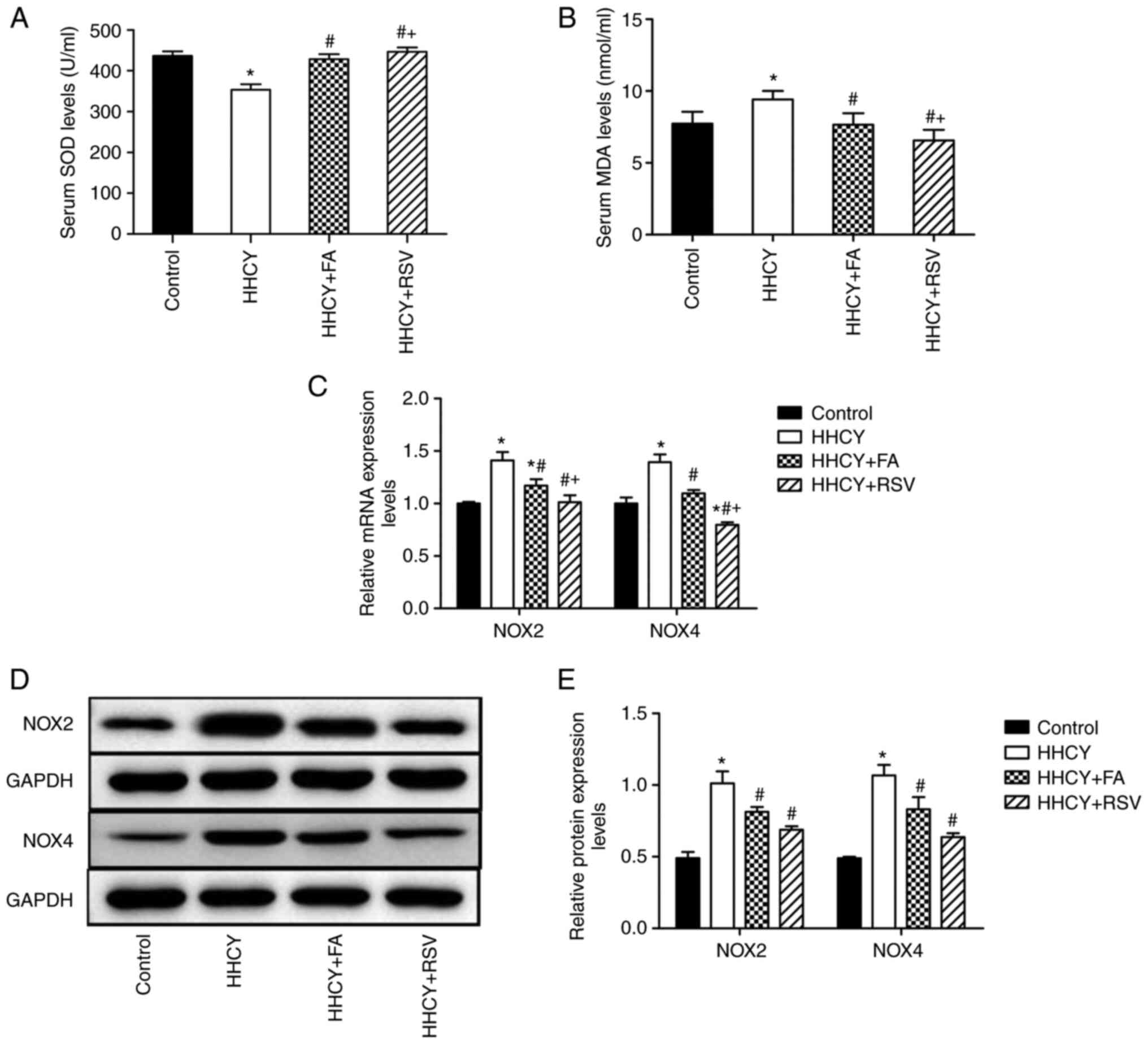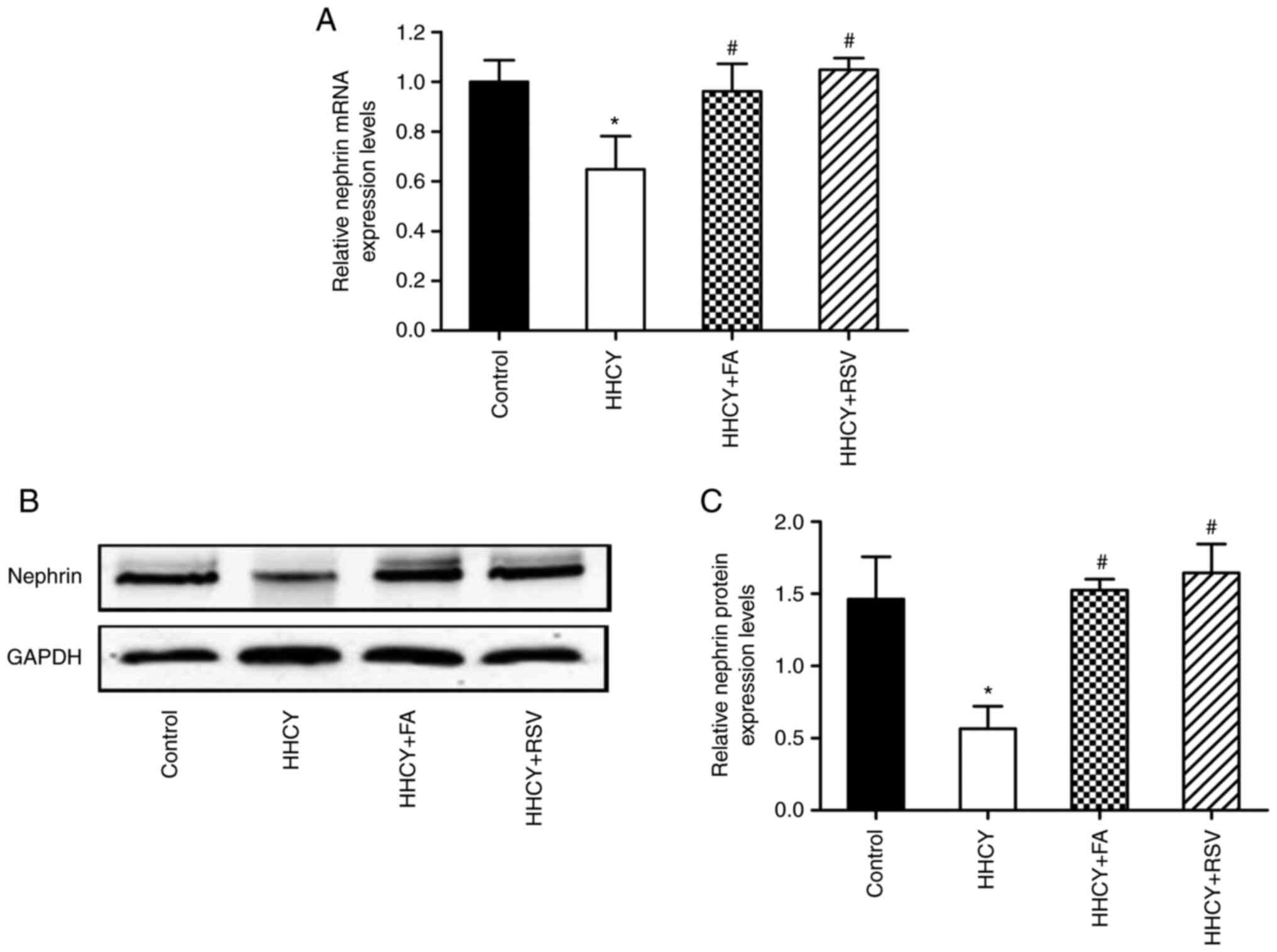|
1
|
Finkelstein JD and Martin JJ:
Homocysteine. Int J Biochem Cell Biol. 32:385–389. 2000.PubMed/NCBI View Article : Google Scholar
|
|
2
|
Zaric BL, Obradovic M, Bajic V, Haidara
MA, Jovanovic M and Isenovic ER: Homocysteine and
Hyperhomocysteinaemia. Curr Med Chem. 26:2948–2961. 2019.PubMed/NCBI View Article : Google Scholar
|
|
3
|
Zhou YF and Guan YF: Hyperhomocysteinemia
and kidney diseases. Sheng Li Xue Bao. 70:607–611. 2018.PubMed/NCBI(In Chinese).
|
|
4
|
Zhao W, Gao F, Lv L and Chen X: The
interaction of hypertension and homocysteine increases the risk of
mortality among middle-aged and older population in the United
States. J Hypertens. 40:254–263. 2022.PubMed/NCBI View Article : Google Scholar
|
|
5
|
Ye Z, Wang C, Zhang Q, Li Y, Zhang J, Ma
X, Peng H and Lou T: Prevalence of homocysteine-related
hypertension in patients with chronic kidney disease. J Clin
Hypertens (Greenwich). 19:151–160. 2017.PubMed/NCBI View Article : Google Scholar
|
|
6
|
Xie D, Yuan Y, Guo J, Yang S, Xu X, Wang
Q, Li Y, Qin X, Tang G, Huo Y, et al: Hyperhomocysteinemia predicts
renal function decline: A prospective study in hypertensive adults.
Sci Rep. 5(16268)2015.PubMed/NCBI View Article : Google Scholar
|
|
7
|
Long Y and Nie J: Homocysteine in renal
injury. Kidney Dis (Basel). 2:80–87. 2016.PubMed/NCBI View Article : Google Scholar
|
|
8
|
Guo G, Sun W, Liu G, Zheng H and Zhao J:
Comparison of oxidative stress biomarkers in hypertensive patients
with or without hyperhomocysteinemia. Clin Exp Hypertens.
40:262–266. 2018.PubMed/NCBI View Article : Google Scholar
|
|
9
|
Gao N, Zhang Y, Li L, Lei L, Cao P, Zhao
X, Lin L and Xu R: Hyperhomocysteinemia-induced oxidative stress
aggravates renal damage in hypertensive rats. Am J Hypertens.
33:1127–1135. 2020.PubMed/NCBI View Article : Google Scholar
|
|
10
|
Gao N, Zhang Y, Lei L, Li L, Cao P, Zhao
X, Lin L and Xu R: Low doses of folic acid can reduce
hyperhomocysteinemia-induced glomerular injury in spontaneously
hypertensive rats. Hypertens Res. 43:1182–1191. 2020.PubMed/NCBI View Article : Google Scholar
|
|
11
|
Shulpekova Y, Nechaev V, Kardasheva S,
Sedova A, Kurbatova A, Bueverova E, Kopylov A, Malsagova K, Dlamini
JC and Ivashkin V: The concept of folic acid in health and disease.
Molecules. 26(3731)2021.PubMed/NCBI View Article : Google Scholar
|
|
12
|
Den*Hartogh DJ and Tsiani E: Health
benefits of resveratrol in kidney disease: Evidence from in vitro
and in vivo studies. Nutrients. 11(1624)2019.PubMed/NCBI View Article : Google Scholar
|
|
13
|
Cheng CK, Luo JY, Lau CW, Chen ZY, Tian XY
and Huang Y: Pharmacological basis and new insights of resveratrol
action in the cardiovascular system. Br J Pharmacol. 177:1258–1277.
2020.PubMed/NCBI View Article : Google Scholar
|
|
14
|
Breuss JM, Atanasov AG and Uhrin P:
Resveratrol and its effects on the vascular system. Int J Mol Sci.
20(1523)2019.PubMed/NCBI View Article : Google Scholar
|
|
15
|
Pyo IS, Yun S, Yoon YE, Choi JW and Lee
SJ: Mechanisms of aging and the preventive effects of resveratrol
on age-related diseases. Molecules. 25(4649)2020.PubMed/NCBI View Article : Google Scholar
|
|
16
|
Atazadegan MA, Bagherniya M, Askari G,
Tasbandi A and Sahebkar A: The effects of medicinal plants and
bioactive natural compounds on homocysteine. Molecules.
26(3081)2021.PubMed/NCBI View Article : Google Scholar
|
|
17
|
Koz ST, Etem EO, Baydas G, Yuce H, Ozercan
HI, Kuloğlu T, Koz S, Etem A and Demir N: Effects of resveratrol on
blood homocysteine level, on homocysteine induced oxidative stress,
apoptosis and cognitive dysfunctions in rats. Brain Res.
1484:29–38. 2012.PubMed/NCBI View Article : Google Scholar
|
|
18
|
Li D, Cui Z, Xu S, Xu T, Wu S, Bouakaz A,
Wan M and Zhang S: Low-intensity focused ultrasound stimulation
treatment decreases blood pressure in spontaneously hypertensive
rats. IEEE Trans Biomed Eng. 67:3048–3056. 2020.PubMed/NCBI View Article : Google Scholar
|
|
19
|
Reastuty R and Haryuna TSH: Correlation of
SOD and MDA expression in the organ of corti and changes in the
function of outer hair cells measured by DPOAE examination in
noise-exposed rat cochlea. Rep Biochem Mol Biol. 10:41–49.
2021.PubMed/NCBI View Article : Google Scholar
|
|
20
|
Livak KJ and Schmittgen TD: Analysis of
relative gene expression data using real-time quantitative PCR and
the 2(-Delta Delta C(T)) Method. Methods. 25:402–408.
2001.PubMed/NCBI View Article : Google Scholar
|
|
21
|
Liu C, Lin L and Xu R: Elevated
homocysteine and differential risks of the renal function decline
in hypertensive patients. Clin Exp Hypertens. 42:565–570.
2020.PubMed/NCBI View Article : Google Scholar
|
|
22
|
Pieroth R, Paver S, Day S and Lammersfeld
C: Folate and its impact on cancer risk. Curr Nutr Rep. 7:70–84.
2018.PubMed/NCBI View Article : Google Scholar
|
|
23
|
Salami M, Salami R, Mafi A, Aarabi MH,
Vakili O and Asemi Z: Therapeutic potential of resveratrol in
diabetic nephropathy according to molecular signaling. Curr Mol
Pharmacol: Dec 17, 2021 (Epub ahead of print).
|
|
24
|
Li KX, Ji MJ and Sun HJ: An updated
pharmacological insight of resveratrol in the treatment of diabetic
nephropathy. Gene. 780(145532)2021.PubMed/NCBI View Article : Google Scholar
|
|
25
|
Chudzińska M, Rogowicz D, Wołowiec Ł,
Banach J, Sielski S, Bujak R, Sinkiewicz A and Grześk G:
Resveratrol and cardiovascular system-the unfulfilled hopes. Ir J
Med Sci. 190:981–986. 2021.PubMed/NCBI View Article : Google Scholar
|
|
26
|
Parsamanesh N, Asghari A, Sardari S,
Tasbandi A, Jamialahmadi T, Xu S and Sahebkar A: Resveratrol and
endothelial function: A literature review. Pharmacol Res.
170(105725)2021.PubMed/NCBI View Article : Google Scholar
|
|
27
|
Dolinsky VW, Chakrabarti S, Pereira TJ,
Oka T, Levasseur J, Beker D, Zordoky BN, Morton JS, Nagendran J,
Lopaschuk GD, et al: Resveratrol prevents hypertension and cardiac
hypertrophy in hypertensive rats and mice. Biochim Biophys Acta.
1832:1723–1733. 2013.PubMed/NCBI View Article : Google Scholar
|
|
28
|
Park S, Lee S, Kim Y, Cho S, Kim K, Kim
YC, Han SS, Lee H, Lee JP, Joo KW, et al: Causal effects of
homocysteine, folate, and cobalamin on kidney function: A mendelian
randomization study. Nutrients. 13(906)2021.PubMed/NCBI View Article : Google Scholar
|
|
29
|
Wartiovaara J, Ofverstedt LG, Khoshnoodi
J, Zhang J, Mäkelä E, Sandin S, Ruotsalainen V, Cheng RH, Jalanko
H, Skoglund U and Tryggvason K: Nephrin strands contribute to a
porous slit diaphragm scaffold as revealed by electron tomography.
J Clin Invest. 114:1475–1483. 2004.PubMed/NCBI View
Article : Google Scholar
|
|
30
|
Tryggvason K and Wartiovaara J: Molecular
basis of glomerular permselectivity. Curr Opin Nephrol Hypertens.
10:543–549. 2001.PubMed/NCBI View Article : Google Scholar
|
|
31
|
Xia M, Conley SM, Li G, Li PL and Boini
KM: Inhibition of hyperhomocysteinemia-induced inflammasome
activation and glomerular sclerosis by NLRP3 gene deletion. Cell
Physiol Biochem. 34:829–841. 2014.PubMed/NCBI View Article : Google Scholar
|
|
32
|
Li H, Xia N, Hasselwander S and Daiber A:
Resveratrol and vascular function. Int J Mol Sci.
20(2155)2019.PubMed/NCBI View Article : Google Scholar
|
|
33
|
Luo M, Cao C, Niebauer J, Yan J, Ma X,
Chang Q, Zhang T, Huang X and Liu G: Effects of different
intensities of continuous training on vascular inflammation and
oxidative stress in spontaneously hypertensive rats. J Cell Mol
Med. 25:8522–8536. 2021.PubMed/NCBI View Article : Google Scholar
|
|
34
|
Buccitelli C and Selbach M: mRNAs,
proteins and the emerging principles of gene expression control.
Nat Rev Genet. 21:630–644. 2020.PubMed/NCBI View Article : Google Scholar
|


















